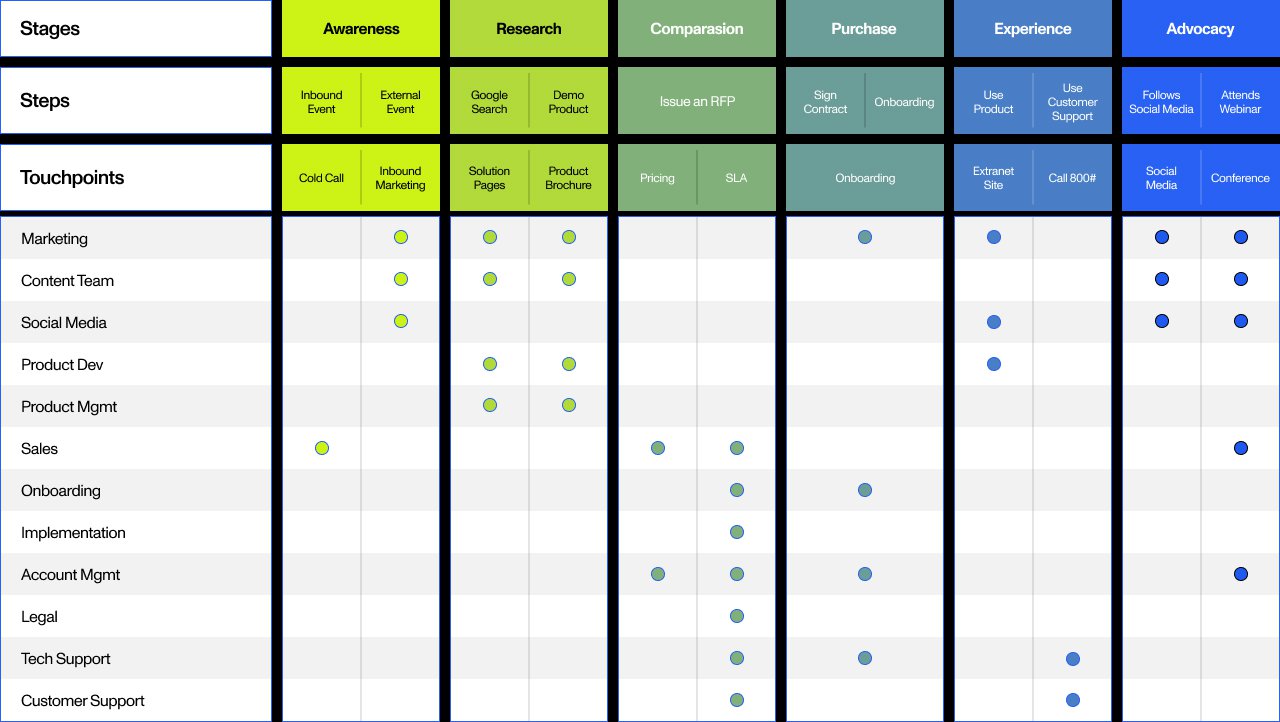Digital & Brand Experience
Mapping the Customer Journey for Optimal Brand Experience
Overview:
What is Digital & Brand Experience?
In a digital-first world, the consumer is the focal point of every decision, from leadership development to growth strategy. Marketers today and in the future will need to focus on refining the brand experience and creating compelling personal stories in order to stay ahead of the digital curve and create loyal customers out of technology-savvy audiences.
Persona Development
A customer persona is a comprehensive representation of a brand’s ideal customer(s). It generally includes demographics (e.g., age, gender, ethnicity, regionality, and occupation) as well as psychographics (e.g., goals, needs, desires, dislikes, and challenges) to provide a “mental model” of high-potential customer targets for the brand.
We use a combination of qualitative and quantitative exploratory customer research techniques to inform persona development and direct the development of many brand activation and expression activities, including website development, customer journey, brand experience, and touchpoint optimization.
Customer Journey Mapping
A customer journey map is a visual representation of the complete experience customers have with a brand. Using customer personas as an input source, it helps explain the experience a target customer should have with a brand through every phase of the purchase funnel—from initial awareness and familiarity through to purchase, loyalty, and advocacy.
Of particular interest are “conversions”—the aspects of experience that tend to facilitate movement from one part of the purchase funnel to another. This path to purchase is increasingly digital, and as such, it needs to account for aspects of the funnel and experience that are both online and offline.
Touchpoint Strategy and Plan
With a comprehensive journey map in place, the next step is to optimize the key touchpoints that comprise the customer journey. A touchpoint is any interaction—whether in-person or virtual, digital, or analog—that helps shape the overall customer experience and reinforce the brand promise. Examples include websites, email marketing, mobile, signage, print collateral, and face-to-face interactions.
Given the number of touchpoints that typically comprise a customer experience, laser-like focus is imperative. We focus on optimizing the touchpoints that provide the “biggest bang for the buck”—those that are most central to the customer journey and can help the brand close any meaningful gaps.

Our Process
Questions
Addressed
- What motivates a brand’s target customer to purchase?
- How does a customer move from first learning about a brand to purchasing it?
- Which touchpoints on the journey are most central to delighting customers?
Typical
Challenges
- Clients find it challenging to focus only on a limited set of personas
- The “typical customer journey” is anything but—i.e., it’s highly variable
- Touchpoints are inherently interrelated—it’s challenging to prioritize them
Ensuring
Success
- Making sure to always lead with the customer perspective
- Using a combination of sources—qualitative/quantitative as well as objective/subjective
- Striking the right balance between art and science
Get to Know More
Differentiate Your Brand with a Customized Experience
Bring Brand Positioning to Life Through Customer Journey Mapping & Touchpoint Optimization
Digital & Brand Experience Case Studies
Let’s get in touch!
Digital & Brand Experience FAQs
A brand experience strategy involves designing and orchestrating all the interactions that people have with a brand across various touchpoints to create a consistent and holistic experience. This strategy integrates branding, marketing, design, and customer service elements to engage consumers emotionally and create a memorable impression that encourages loyalty and advocacy.
Brand experience is essential because it directly influences customer loyalty and retention. When customers consistently enjoy positive interactions with a brand, they are more likely to become repeat buyers and even brand advocates, sharing their positive experiences with others. This loyalty not only bolsters a brand's reputation but also enhances its competitive edge by differentiating it in crowded markets. A distinctive and engaging brand experience sets a company apart from its competitors, making it a key factor in consumer decision-making.
Additionally, strong brand experiences foster deeper emotional connections with customers. These connections drive engagement across various platforms, turning casual buyers into dedicated fans and active promoters of the brand. Thus, the overall brand experience shapes not just immediate sales but the long-term success and sustainability of a brand.
The best brand experiences not only delight customers—they do so in a way that is true to their brand positioning. The following examples highlight how companies can successfully integrate their brand's core values with consumer experiences, creating environments that not only meet but exceed customer expectations and foster brand loyalty and advocacy:
Apple’s retail stores: Apple's stores are designed to be more than just shops where you buy products. They are spaces that allow customers to experience Apple's technology firsthand in an environment that reflects the brand's design ethos. Each store features a minimalist design, uses premium materials, and includes areas like the "Genius Bar" for personalized technical support. This setting showcases their products and educates and engages customers through workshops and product demonstrations, enhancing their connection to the brand.
Disney’s theme parks: Disney's theme parks are renowned for creating magical experiences that are meticulously themed and rich in detail. From the moment guests enter, every element—from the staff (cast members) to the architecture—contributes to a cohesive storytelling experience. These parks excel in immersive entertainment, offering attractions and parades featuring beloved characters, reinforcing visitors' emotional bonds with the Disney brand.
Nike’s flagship stores and interactive apps: Nike has integrated digital technology with physical retail to revolutionize the shopping experience. Their flagship stores often feature areas for product customization, interactive sessions for testing products, and integration with the Nike app to provide a personalized shopping journey. This approach not only makes shopping more engaging but also builds a community among Nike customers, particularly through app features that track athletic achievements and offer personalized coaching.
Brand experience refers to the sum of all interactions a customer has with a brand, shaped by elements like visual identity, communications, and emotional engagement. User experience (UX), on the other hand, specifically focuses on the usability, design, and functionality of products and digital interfaces. Customer experience (CX) encompasses every interaction along the customer journey, from pre-purchase to post-purchase, including interactions with products, services, and customer support. The main difference between a customer experience and a brand experience is the latter is uniquely crafted to be consistent with the brand’s unique positioning.
Brand experience involves all interactions a consumer has with a brand, from advertising and customer service to purchase and usage. It shapes the customer’s perception of the brand's identity and values, aiming to build a lasting emotional connection.
Product experience focuses on a consumer's direct interaction with a product, including its usability, features, and design. It's concerned with the user's immediate satisfaction and the utility they derive from the product, directly affecting their perception of the brand.
While brand experience encompasses the broader emotional and psychological impact of the brand, product experience is about the specific functionalities and benefits of the product. Both are interconnected, with product experience influencing overall brand perception and loyalty.
A great brand experience ultimately leads to increased customer satisfaction, loyalty, and advocacy, as it not only meets but often exceeds customer expectations. Key elements of a brand experience strategy include:
Emotional connection: Brands that succeed in creating an emotional bond with their customers tend to enjoy higher loyalty and advocacy. This involves invoking positive feelings through storytelling, customer service, and the overall ambiance that resonates with the brand’s values.
Personalization: Tailoring the experience to individual customer needs and preferences shows that a brand values its customers and understands their unique requirements. Personalization can range from customized marketing messages to personalized products or recommendations.
Engagement: A good brand experience actively engages customers, making them feel involved and important to the brand. This can be achieved through interactive elements in stores, engaging content on social media, or community-building activities.
Innovative and memorable: Offering unique experiences that customers can’t find elsewhere can make a brand stand out. This could be through innovative use of technology, unique product offerings, or creative marketing campaigns.
Consistency across all channels and touchpoints: Whether interacting online, in-store, or through customer service, the brand experience should be uniform and consistent. This helps in building trust and reinforcing the brand identity.
Simplicity and ease: The experience should be straightforward and intuitive, removing any barriers that could lead to frustration. This includes easy navigation on websites, hassle-free return policies, or simple checkout processes in stores.





